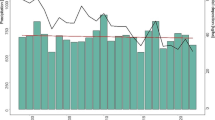Abstract
To ensure that water resources are not damaged during coal mining, the height of the water conducted zone in coal mining is explored in this study. When mining coal mines, the height of the water conducted zone is complex and unstable when making predictions. Therefore, the Internet of things perception technology is applied to solve the problem of inaccurate data collection. Moreover, the multiple regression analytical method is introduced to obtain the prediction equation for the height of the water conducted zone. The research results show as follows: by using the Internet of things sensing technology, when collecting data, the redundant and error data can be excluded before the data fusion, which can improve the validity of the data. The multiple regression analysis methods are used to summarize and conclude the data by using the linear regression method; therefore, the obtained prediction equation can accurately predict the height of the water conducted zone, which solves the problem caused by using traditional empirical equations in coal mining in the past that leads to a large error in the prediction height. By using the Internet of things perception technology to predict the height of the water conducted zone in coal mining, the collected data are more accurate and the prediction results are more effective. Therefore, this method can effectively protect water resources during coal mining.





Similar content being viewed by others
References
Arthur LM, Weakley AT, Griffiths PR et al (2016) Direct-on-filter ?-quartz estimation in respirable coal mine dust using transmission Fourier transform infrared spectrometry and partial least squares regression. Appl Spectrosc 71(5):1014
Beneš M, Krupička L. Weak solutions of coupled dual porosity flows in fractured rock mass and structured porous media. 2016, 433(1), pp. 543–565
Duan ZH, Wu TTH, Guo SW et al (2018) Development and trend of condition monitoring and fault diagnosis of multi-sensors information fusion for rolling bearings: a review. Int J Adv Manuf Technol 96(1–4):803–819
Gao XD, Sun Y, You DY et al (2015) Multi-sensor information fusion for monitoring disk laser welding. Int J Adv Manuf Technol 85(5–8):1167–1175
Liu SL, Li WP, Wang QQ (2017a) Height of the water-flowing fractured zone of the Jurassic coal seam in Northwestern China. Mine Water & the Environment 37(3):312–321
Liu C, Jin Gong E et al (2017b) Prediction for the performance of gas turbine units using multiple linear regression. Proceedings of the Csee 37(16):4731–4738
Lu T, Liu SD, Wang B et al (2017) A review of geophysical exploration technology for mine water disaster in China: applications and trends. Mine Water & the Environment 36(5):1–10
Mathapelo PS, McCrindle RI, Combrinck S et al (2016) Hazard assessment of polycyclic aromatic hydrocarbons in water and sediment in the vicinity of coalmines. Journal of Soils & Sediments 16(12):1–13
Słota K, Słota Z, Kułagowska E (2016) Thermal load at workstations in the underground coal mining: results of research carried out in 6 coal mines. Med Pr 67(4):477–498
Wang X, Meng FB (2018) Statistical analysis of large accidents in China’s coal mines in 2016. Natural Hazards Journal of the International Society for the Prevention & Mitigation of Natural Hazards 92(4):311–325
Wang XL, Qin QR, Fan CH (2017a) Failure characteristic and fracture evolution law of overburden of thick coal in fully mechanized sub-level caving mining. J Eng Geol 46(11):2041–2048
Wang W, Wang Q, Sohraby K (2017b) Multimedia sensing as a service (MSaaS), pp. Exploring resource saving potentials of at Cloud-Edge IoT and fogs. IEEE Internet Things J 4(2):487–495
Wang ZC, Wang C, Wang ZC (2018) The hazard analysis of water inrush of mining of thick coal seam under reservoir based on entropy weight evaluation method. Geotech Geol Eng 36(5):3019–3028
Yan PC, Zhou MR, Liu QM, Zhang KY, He CY (2016) Research on the source identification of mine water inrush based on LIF technology and SIMCA algorithm. Spectroscopy & Spectral Analysis 36(1):243–247
Yang Y, Lv P (2017) Comprehensive determination of the height of water flowing fractured zone in super close upward mining. Liaoning Gongcheng Jishu Daxue Xuebao 36(4):371–376
Author information
Authors and Affiliations
Corresponding author
Additional information
This article is part of the Topical Collection on Geological Modeling and Geospatial Data Analysis
Rights and permissions
About this article
Cite this article
Yan, Z., Chang, X. & Wang, Y. The prediction of water conducted zone in coal mining by Internet of things perception. Arab J Geosci 13, 852 (2020). https://doi.org/10.1007/s12517-020-05833-6
Received:
Accepted:
Published:
DOI: https://doi.org/10.1007/s12517-020-05833-6




